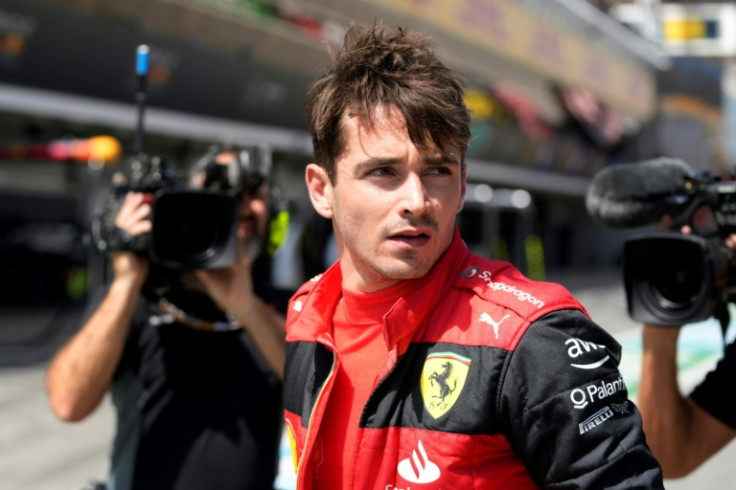Why Were Lewis Hamilton And Charles Leclerc Disqualified From US Grand Prix?
Fans of both Mercedes and Ferrari are still asking a number of questions days after the conclusion of the US Grand Prix last Sunday.

The US Grand Prix weekend started on a high for both Ferrari driver Charles Leclerc and Mercedes star Lewis Hamilton, who qualified on pole position and P3, respectively. However, they both went from hero to zero by the end of Sunday's main race after being disqualified following a technical inspection of their cars.
While days have passed since the decision was made and both teams have accepted their fate, many fans are still struggling to wrap their heads around exactly what happened.
The seven-time world champion finished in P2 and even stood on the podium beside race winner Max Verstappen and third-place finisher Lando Norris. Leclerc finished in P6, but both of them were later stripped of their positions, promoting Leclerc's teammate Carlos Sainz to the final podium spot.
What led to the disqualification?
FIA Technical Delegate Jo Bauer and his team went through their standard post-race checks. The operative term here is "standard", meaning the technical inspection done at the Circuit of the Americas is not something new. It just so happens that this often goes on quietly if no irregularities are found in any of the cars that are inspected.
Among a number of tests is "a physical floor and a plank wear inspection", which is done on randomly selected cars. In Austin, the stewards selected Hamilton (Mercedes), Leclerc (Ferrari), race winner Verstappen (Red Bull) and the McLaren of Lando Norris.
The plank, also known as a "skid block" is located at the bottom of each car and it ensures that cars aren't running too close to the ground, resulting in an aerodynamic advantage. Bauer reported that after the inspections, his team found Hamilton and Leclerc's skid blocks "to be not in compliance" with the rules.
Both Lewis Hamilton and Charles Leclerc were disqualified following the conclusion of Sunday's Grand Prix for breaching Technical Regulations ❌
— Formula 1 (@F1) October 23, 2023
Click below to read more on the specifics of their disqualification 👇#F1 #USGPhttps://t.co/RTVHelYP0h
What was wrong with the floor planks on the Mercedes and Ferrari?
According to Article 3.5.9 e) of the 2023 FIA Formula One Technical Regulations: "The thickness of the plank assembly measured normal to the lower surface must be 10mm ± 0.2mm [plus or minus 0.2 millimetres] and must be uniform when new.
"A minimum thickness of 9mm will be accepted due to wear, and conformity to this provision will be checked at the peripheries of the designated holes."
Needless to say, both cars fell below the allowable thickness of certain parts of their skid blocks at the end of the race.
How did the teams react?
Surprisingly, there was not a lot of push back from both teams compared to controversial situations in the past where penalties led to a number of conversations and appeals. According to the FIA, both Mercedes and Ferrari "acknowledged that the measurement performed by the FIA Technical Team was correct and stated that the high wear on the skid pads was probably a result of the unique combination of the bumpy track and the Sprint race schedule that minimised the time to set up and check the car before the race".
Ferrari even took to social media to speak to their fans and to explain exactly what happened from their point of view.
Our Sporting Director, Diego Ioverno, explains @charles_leclerc's disqualification from the #USGP pic.twitter.com/cZFEvInIuc
— Scuderia Ferrari (@ScuderiaFerrari) October 23, 2023
Ferrari Sporting Director Diego Ioverno said: "Our car was below the minimum threshold by a few tenths [of a millimetre], but enough to bring the stewards to consider [our car] illegal. The Sprint weekend is very peculiar. You have very little time to prepare the car, basically only one session, FP1, and then you go into parc ferme."
He shared that from that point, the teams were committed to the ride height they had chosen. He said that they had lifted the car in FP1, but in the end it was not enough thanks to a number of factors including the bumpy track and the intense gusts of wind at COTA.
He also said that even if they had the opportunity, they may have not chosen to lift the car further as it would have already compromised their speed. Leclerc would also need to start from the pit lane in that case.
As for Mercedes, Team Principal Toto Wolff also accepted the blow without much resistance. Trackside Engineering Director Andrew Shovlin admitted his disappointment after losing Hamilton's P2, and slammed the Sprint Race format for the issue.
"Unfortunately, it is one of the pitfalls of the Sprint format where we have a solitary hour of running before parc ferme. Without running at a race fuel load in FP1, combined with a circuit as bumpy as this and the parts of the track where the drivers have to put the car during the Grand Prix, have contributed to the higher than expected wear levels. We will go away and learn from this but also take the positives from our experience as a whole."
Meanwhile, fans are questioning why other cars are not subjected to the same inspections. Unfortunately, the rules only require random inspections for selected cars. How fair that might be is certainly something that should perhaps be further discussed.
© Copyright IBTimes 2025. All rights reserved.






















